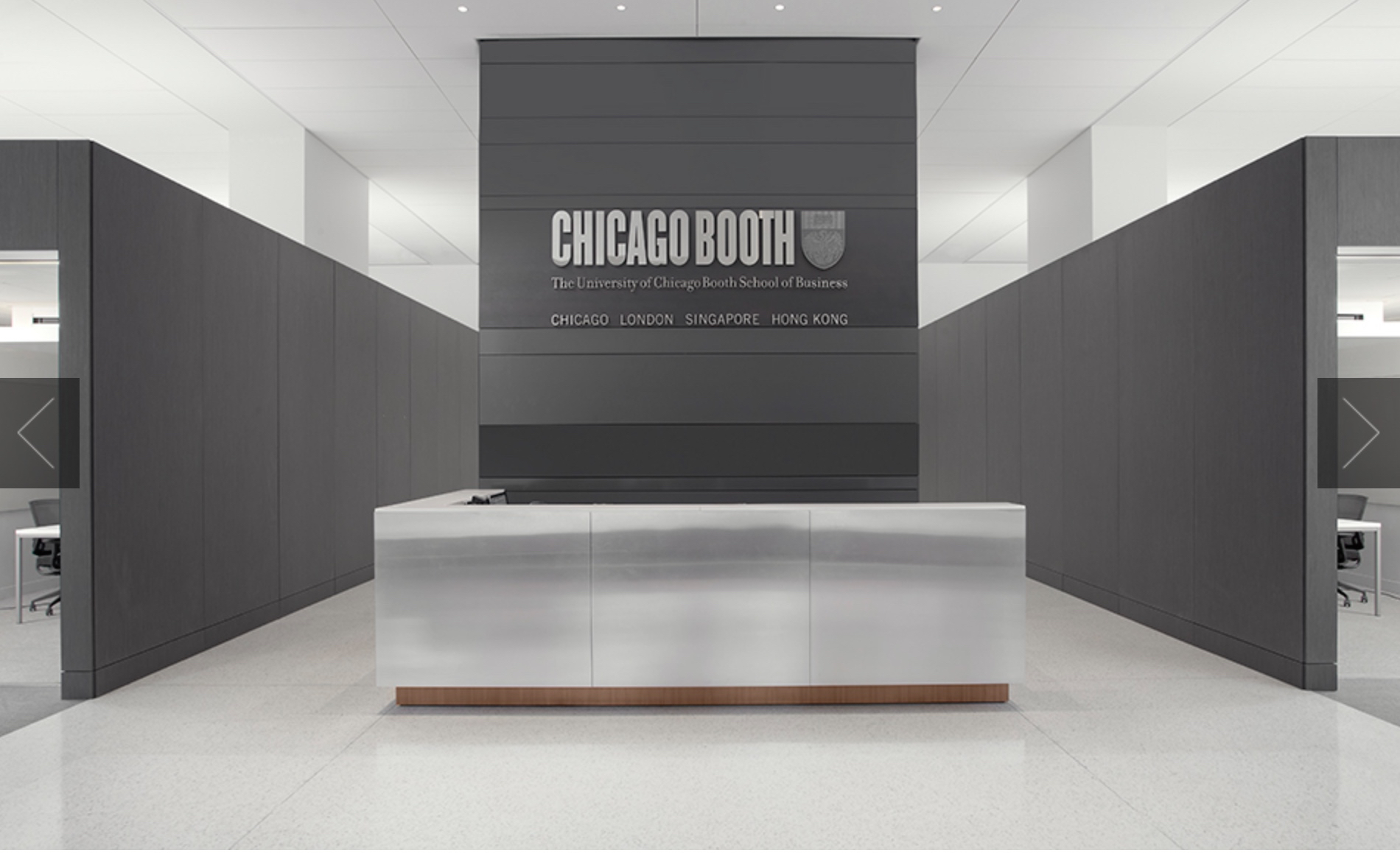Contract Design Magazine Ι March 4, 2015
The University of Chicago Booth School of Business, one of the top of its kind in the country, needed a new collaborative space that reflected the future with a global presence. In sharp contrast with the Booth School of Business Gleacher Center, the recently opened annex to the Gleacher Center is more future-forward, restrained, and less stodgy “business school” in its appearance. And that’s by design.
First, here is what the annex was designed in reaction to: When entering the Gleacher Center—completed in 1994 just north of the Chicago River in downtown Chicago—one sees dark wood, a maroon-marbled lobby, and a portrait of the building’s namesake financier Eric J. Gleacher seated in a wooden chair in front of a Chippendale highboy cabinet. The interiors of the Gleacher Center, and even that painting, tap into a much older and now outdated image of a business school. But across the street, the 15,000-square-foot Gleacher Center Annex sets that patriarchal look aside.
Located on the ground floor of NBC Tower and designed by Chicago-based Woodhouse Tinucci Architects, the annex is concerned with theory and data, not historical design tropes and elite subcultures. Intensely minimalist and abstract, it presents a business culture that applies equally to its increasingly diverse range of students—not just those who see a future version of themselves in the Gleacher portrait. Even the art on the walls draws a sharp distinction. The interior’s restrained color and material palette embody a school that is a technocratic and transparent expression of how information technology and the availability of data have reshaped business education.
The annex is planned with three parallel bands of programmatic elements. The first is largely public and social: Beyond the glass wall lining the street front, an open lounge area is flanked by meeting rooms on each side, with one nearly entirely enclosed by floor-to-ceiling glass. Students encounter a custom-designed, floor-to-ceiling display wall lacquered in four tones of gray, containing the school’s logo and fronted by a stainless steel desk.
Behind the display wall is a bar and reception area used for events. A long walnut table with a stainless steel countertop is surrounded by wire mesh Bertoia chairs. Throughout, rectilinear lighting fixtures by Birchwood are a consistent presence, including custom-designed square outline chandeliers in one of the front meeting rooms.
The second programmatic band consists of gray oak pavilions with walnut doors and glass walls that contain 16 study rooms. Because they’re not connected to the 18-foot ceiling, these pavilions make the surrounding space feel light and airy. From the study rooms facing the lounge, students have views through glass out to the street. Woodhouse Tinucci Principal Andy Tinucci, AIA, says that the use of glass was a way to convey notions of transparency in business and to encourage a visible relationship with the city beyond. “There’s total transparency through [to] the city, the social areas, and the learning [spaces],” he says.
In the third programmatic band, two large lecture halls are adjacent to an experimental classroom, which is fronted with fritted glass. The fritting on the glass wall superimposes three layers of sloping, parallel lines resembling a bar graph and alluding to the focus on data and theory over tradition and history. The other three walls feature large media screens, which students—seated in six groups of six—can access from their computers. “It’s more [about] building for the future than something we’ve got an immediate need for,” says Booth School Executive Director of Facilities and Operations Ronald Gemkow. “We want to be prepared, and give our faculty the option to teach in a different fashion.”
An art gallery–like setting
The subdued shades of gray and white throughout the annex rely on the business school’s world-class art collection to give spaces depth and color. “In a way, it’s an art gallery,” says David Woodhouse, FAIA, principal of Woodhouse Tinucci Architects. “The activity and the art come to the fore.” Abstract, non-representational art works and the lack of typical business school design cues reinforce Booth’s identity as a global school in a more democratic realm with satellite programs in Europe and Asia. “That’s one of the things that I think is kind of limiting about the [neighboring Gleacher Center],” says Woodhouse. “It only speaks to a certain culture. The school has a much more globalized culture now.”
The University of Chicago is undergoing many significant architecture and interior design projects overseen by Steven Wiesenthal, FAIA, senior associate vice president and university architect. This annex, while not on the main campus, is integral to the university’s goal of broadened, modern architectural appeal. “While off-campus in downtown Chicago,” Wiesenthal says, “the architects successfully translated the design principles that have informed all of our projects during this period of campus transformation, creating a place that’s all about the robust exchange of ideas.”
University of Chicago Booth School of Business Gleacher Center Annex
Architect: Woodhouse Tinucci Architects
Client: University of Chicago Booth School of Business
Where: Chicago
What: 15,000 total square feet on one floor
Cost/sf: $220
